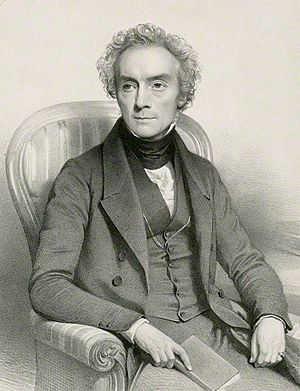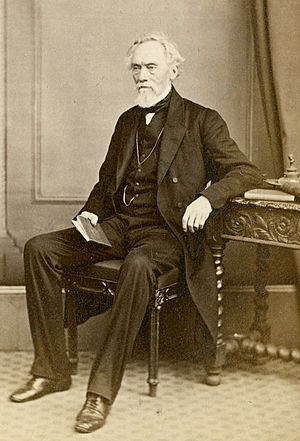Archibald Billing facts for kids
Archibald Billing (born 10 January 1791 – died 2 September 1881) was an important English doctor and a writer who also loved art. He was a Fellow of the Royal Society, which is a very high honor for scientists.
Contents
A Doctor's Life
Archibald Billing was born in Dublin, Ireland. His father was Theodore Billing. Archibald went to Trinity College Dublin in 1807. He studied hard and earned his first degree in 1811. Later, he became a doctor in 1818.
He spent seven years learning in hospitals in Ireland, Britain, and other parts of Europe. Around 1815, he moved to London. He became a member of the College of Physicians, a group of leading doctors, in 1819. He also held important roles there, like being a "censor" in 1823 and a "councillor" for several years.
Working at London Hospital
Billing worked for a long time at the London Hospital. He started teaching there in 1817. In 1822, he became a doctor at the hospital. He began giving special lessons called clinical lectures in 1823. These were lessons where students learned by observing patients. He stopped teaching in 1836 and left his job as a doctor there in 1845.
When the University of London started in 1836, Billing was asked to join its senate. This is like a governing body for the university. He was very important in the university for many years. He also helped examine students who wanted to become doctors. Besides this, he was a member of other science and medical groups.
Archibald Billing had a very successful career. He stopped working many years before he passed away. He died on 2 September 1881 at his home in Park Lane, London. He was one of the last doctors in London to visit his patients while riding a horse! He is buried in the Kensal Green Cemetery in London.
His Medical Books
Dr. Billing wrote several important medical books. His most famous one was called First Principles of Medicine. It was first published in 1831 as a small book. Over time, it grew into a large textbook. It was so popular that it was printed six times!
He also wrote:
- On the Treatment of Asiatic Cholera (1848)
- Practical Observations on Diseases of the Lungs and Heart (1852)
- He also published Clinical Lectures in a medical journal called Lancet in 1831.
Billing used his own experiences to write these books. He wanted to base medicine on pathology, which is the study of diseases. He was a clear writer and focused on being very accurate.
New Medical Ideas
Archibald Billing was known for bringing new ideas to medicine. He paid special attention to problems with the chest, like lung and heart diseases. He was one of the first teachers in London to make auscultation a regular part of learning. Auscultation means listening to sounds inside the body, often with a stethoscope.
He also had new ideas about how the heart makes sounds. He first shared these ideas in 1832. Even though he started as an innovator, he became more traditional later in his life.
His Other Talents
Dr. Billing was not just a doctor. He was a very cultured man with many hobbies. He was an amateur artist, meaning he enjoyed art as a hobby. He was also an expert in old engraved gems, coins, and similar items.
He even wrote a book about these interests called The Science of Gems, Jewels, Coins, and Medals, Ancient and Modern in 1867. This book included a small autobiography of an artist named Benedetto Pistrucci, which Billing's wife translated. It was a detailed book with photographs and had a second edition.
Billing also loved music. On 12 May 1833, he hosted a special musical event at his home. Famous musicians like Mendelssohn, Paganini, and the cellist Robert Lindley played music together there!



